Current Research Journal of Biological Sciences 4(4): 507-512, 2012 ISSN: 2041-0778
advertisement
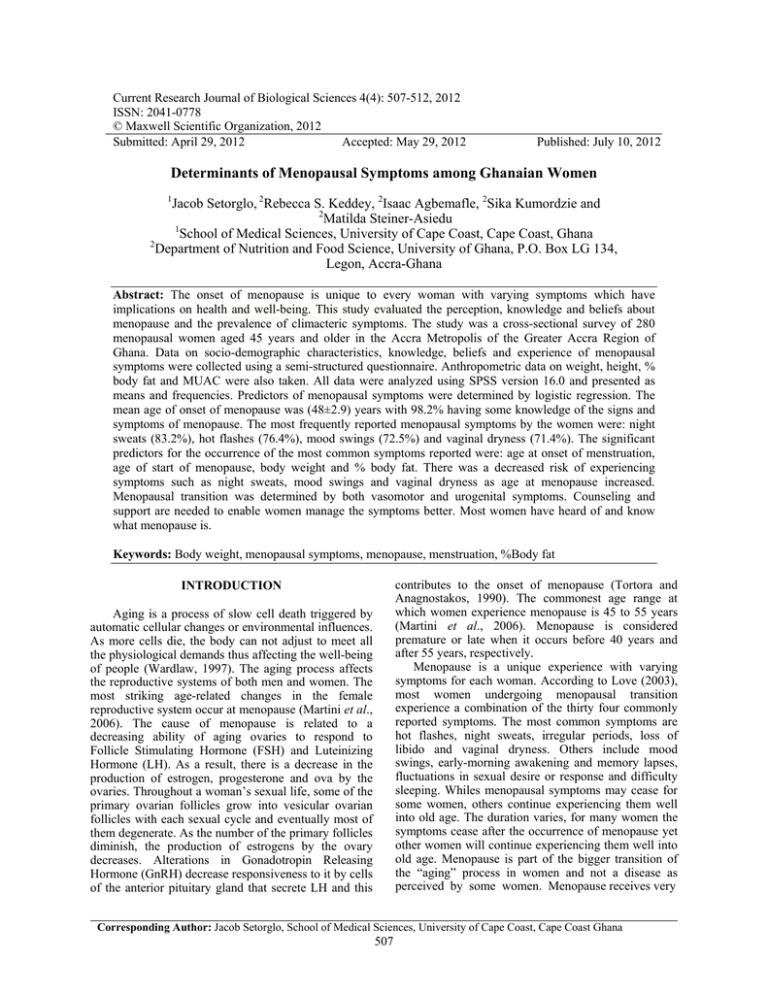
Current Research Journal of Biological Sciences 4(4): 507-512, 2012
ISSN: 2041-0778
© Maxwell Scientific Organization, 2012
Submitted: April 29, 2012
Accepted: May 29, 2012
Published: July 10, 2012
Determinants of Menopausal Symptoms among Ghanaian Women
1
Jacob Setorglo, 2Rebecca S. Keddey, 2Isaac Agbemafle, 2Sika Kumordzie and
2
Matilda Steiner-Asiedu
1
School of Medical Sciences, University of Cape Coast, Cape Coast, Ghana
2
Department of Nutrition and Food Science, University of Ghana, P.O. Box LG 134,
Legon, Accra-Ghana
Abstract: The onset of menopause is unique to every woman with varying symptoms which have
implications on health and well-being. This study evaluated the perception, knowledge and beliefs about
menopause and the prevalence of climacteric symptoms. The study was a cross-sectional survey of 280
menopausal women aged 45 years and older in the Accra Metropolis of the Greater Accra Region of
Ghana. Data on socio-demographic characteristics, knowledge, beliefs and experience of menopausal
symptoms were collected using a semi-structured questionnaire. Anthropometric data on weight, height, %
body fat and MUAC were also taken. All data were analyzed using SPSS version 16.0 and presented as
means and frequencies. Predictors of menopausal symptoms were determined by logistic regression. The
mean age of onset of menopause was (48±2.9) years with 98.2% having some knowledge of the signs and
symptoms of menopause. The most frequently reported menopausal symptoms by the women were: night
sweats (83.2%), hot flashes (76.4%), mood swings (72.5%) and vaginal dryness (71.4%). The significant
predictors for the occurrence of the most common symptoms reported were: age at onset of menstruation,
age of start of menopause, body weight and % body fat. There was a decreased risk of experiencing
symptoms such as night sweats, mood swings and vaginal dryness as age at menopause increased.
Menopausal transition was determined by both vasomotor and urogenital symptoms. Counseling and
support are needed to enable women manage the symptoms better. Most women have heard of and know
what menopause is.
Keywords: Body weight, menopausal symptoms, menopause, menstruation, %Body fat
contributes to the onset of menopause (Tortora and
Anagnostakos, 1990). The commonest age range at
which women experience menopause is 45 to 55 years
(Martini et al., 2006). Menopause is considered
premature or late when it occurs before 40 years and
after 55 years, respectively.
Menopause is a unique experience with varying
symptoms for each woman. According to Love (2003),
most women undergoing menopausal transition
experience a combination of the thirty four commonly
reported symptoms. The most common symptoms are
hot flashes, night sweats, irregular periods, loss of
libido and vaginal dryness. Others include mood
swings, early-morning awakening and memory lapses,
fluctuations in sexual desire or response and difficulty
sleeping. Whiles menopausal symptoms may cease for
some women, others continue experiencing them well
into old age. The duration varies, for many women the
symptoms cease after the occurrence of menopause yet
other women will continue experiencing them well into
old age. Menopause is part of the bigger transition of
the “aging” process in women and not a disease as
perceived by some women. Menopause receives very
INTRODUCTION
Aging is a process of slow cell death triggered by
automatic cellular changes or environmental influences.
As more cells die, the body can not adjust to meet all
the physiological demands thus affecting the well-being
of people (Wardlaw, 1997). The aging process affects
the reproductive systems of both men and women. The
most striking age-related changes in the female
reproductive system occur at menopause (Martini et al.,
2006). The cause of menopause is related to a
decreasing ability of aging ovaries to respond to
Follicle Stimulating Hormone (FSH) and Luteinizing
Hormone (LH). As a result, there is a decrease in the
production of estrogen, progesterone and ova by the
ovaries. Throughout a woman’s sexual life, some of the
primary ovarian follicles grow into vesicular ovarian
follicles with each sexual cycle and eventually most of
them degenerate. As the number of the primary follicles
diminish, the production of estrogens by the ovary
decreases. Alterations in Gonadotropin Releasing
Hormone (GnRH) decrease responsiveness to it by cells
of the anterior pituitary gland that secrete LH and this
Corresponding Author: Jacob Setorglo, School of Medical Sciences, University of Cape Coast, Cape Coast Ghana
507
Curr. Res. J. Biol. Sci., 4(4): 507-512, 2012
little attention because most women feel it is a phase
that every woman must go through when they reach the
time. There is therefore the need for documentation of
concerns and issues specific to types and number of
menopausal symptoms and lifestyles among
menopausal women in Ghana. This will add to existing
knowledge and direct educational strategies and
policies for better adult reproductive health in Ghana
and elsewhere. This study therefore evaluated the
perception, knowledge and beliefs about menopause
and the prevalence of the climacteric symptoms among
menopausal women aged 45 years and older in Accra,
Ghana.
MATERIALS AND METHODS
Study design and setting: This was a cross-sectional
study of randomly sampled 280 menopausal women
from Accra Metropolis who consented to the study. The
study was conducted between October 2010 and June
2011
Data collection: A semi-structured, pretested
questionnaire was administered to obtain information
on socio-demographic characteristics, knowledge,
beliefs and menopausal symptoms experienced by the
women. Height was measured to the nearest 0.1 cm and
keyed into the body fat analyzer (Omron Fat Loss
Monitor Scale) which was used to determine the
weight, BMI and % body fat of the menopausal women.
MUAC was also measured to the nearest 0.1 cm. All
measurements were done in duplicates.
Data analysis: Data collected were analyzed using
SPSS version 16.0. Frequencies were used to
summarize categorical variables whiles continuous
variables were presented as mean±standard deviation of
two determinations. Logistic regression analysis was
used to determine the factors associated with
menopause.
RESULTS AND DISCUSSION
Menopause is a global physiological milestone in
any woman’s life, yet this unique phenomenon has
shown
differences
in
symptom
frequencies,
perceptions, knowledge, body composition and body fat
distribution according to ethnic, cultural, social and
geographical location (Loutfy et al., 2006; Toth et al.,
(2000). The mean age of the participants were
(53.0±4.3) years and most of them (60%) were married.
Most of the women were between the ages of 50 to 59
years (67.9%) but 78.2% attained menopause
Table 1: Socio-demographic characteristics of participants (N = 280)
Characteristics
n (%)
Age (years)
53±4.3
Mean (SD)
45-49 years
66 (23.5)
50-59 years
190 (67.9)
60 years and above
24 (8.6)
Ethnicity
Akan
131 (46.8)
Ewe
45 (16.1)
Ga
77 (27.5)
Northerner
22 (7.9)
Other
5 (1.8)
Marital status
Married
170 (60.7)
Separated
48 (17.1)
Divorced
18 (6.0)
Widowed
41 (14.6)
Never married
3 (1.1)
Highest level of formal education
Never attended school
6 (2.1)
Basic school
27 (9.6)
Secondary school
44 (15.7)
Tertiary
203 (72.5)
Age (years) at menopause
48±2.9
Mean (SD)
<45
21 (7.5)
45-50
219 (78.2)
>50
40 (14.3)
Table 2: BMI and body fat profile of women (N = 280)
Variables
BMI (kg/m2)
Mean (SD)
<18.5
18.5-24.9
25.0-29.9
≥30.0
Mean %body fat (SD)
≤34%
>34%
29.8±1.7
1 (0.4)
34 (12.1)
124 (44.3)
121 (43.2)
43.1±4.6
7 (2.5)
273 (97.5)
between 45-50 years and 72.5% of the women had
tertiary education (Table 1).
Majority of the women (46.8%) were Akans, Gas
(27.5%) and Ewes were 16.1%. The finding is
consistent with mean age (49.4±3) at which menopause
occurred as reported for sub Saharan Africa
(Kwawukume et al., 1993). According to Biela (2002),
the Age at Natural Menopause (ANM) varies due to
environmental and genetic factors. Other factors which
accelerate ANM are: nulliparity, short-length menstrual
cycles and unilateral oophorectomy. Menopause
transition is associated with deleterious changes in body
composition and body fat distribution (Toth et al.,
2000). Out of the 280 participants, 44.3% of them were
overweight, 12.1% were normal and 0.4% was
underweight but majority of the women (97.5%) had
high percentage fat (Table 2).
508 n(%)
Curr. Res. J. Biol. Sci., 4(4): 507-512, 2012
Table 3: Knowledge and beliefs about menopause (N = 280)
Questions
Do you know what is meant by Menopause?
Do you know some signs and symptoms of menopause?
Do you think it is a disease?
Does menopause make one fat?
Do you believe it is important for health professionals to educate the
public on it?
Do you think it is important to know about the symptoms of
menopause?
As a woman if you know, can you have an impact on other females?
Do you believe having the knowledge can help manage your
symptoms better?
Do you believe exercise (e.g., walk) can help manage your
symptoms?
A greater percentage of the participants were found to
be overweight and obese and also had a higher
percentage of body fat. This compares well with a study
conducted in the United States of America which
revealed that adult American women tend to gain
weight with age and many women report that their
weight gain started around the time of onset of
menopause (Heymfield et al., 1994). Moreover as
women age, there are changes in body composition that
include losses in bone mineral and body cell mass and
increase in total body fat, visceral fat and extracellular
fluid and it appears that these body composition
changes begin or accelerate during the menopausal
years (Heymfield et al., 1994). Menopausal status
where there is low level of sex hormones (estrogen and
androgens) remained a significant predictor of these
changes in body composition even taking into account
other predictors such as age and education level.
Estrogen levels decline progressively with menopausal
transition, whereas the ovaries continue to secrete small
amounts of androgen (Ho et al., 2010). In adult women
androgens are necessary for estrogen synthesis and
have been shown to play key roles in increasing libido,
energy, bone mineral density and muscle mass and
strength (Synder, 2001).
According to a study by Pan et al. (2002), a great
deal of knowledge about menopause has been
introduced to Taiwanese women. A great majority
(98.2%) of participants already knew some signs and
symptoms of menopause (Table 3). They described
menopause as being caused by changes in hormones,
old age and decrease in estrogen production. Similarly,
Fecteau, 2002 in his study reported that all participating
Responses {n (%)}
----------------------------------------------------------------------------------yes
no
don’t know
_
32 (11.4)
248 (88.6)
_
5 (1.8)
275 (98.2)
8 (2.9)
247 (88.2)
25 (8.9)
35 (12.5)
176 (62.9)
69 (24.6)
279 (99.6)
1 (0.4)
_
280 (100.0)
_
_
274 (97.9)
3 (1.1)
3 (1.1)
280 (100.0)
_
_
216 (77.1)
27 (9.6)
37 (13.2)
women described menopause as a change in hormone
levels while others conclude that menopause occurs
when a woman surpasses her child bearing years or no
longer gets her period. When asked about the benefits
of education, 99.6% of the women believed it was
important for health professional to educate the public
on it. All the women (100%) believed it was important
to know about the symptoms of menopause which
could help them manage their symptoms better.
Majority, 77.1%, of women believed exercising could
help manage the symptoms better while 13.2% had no
idea about the benefits of exercising (Table 3). The high
knowledge about menopause could be attributed to the
fact that most of the women had received some form of
formal education with the majority reaching the tertiary
level and therefore might have read about it from
books, other print materials, radio or television since
the most commonly indicated source of knowledge on
menopause was reading material, such as newspapers
and magazines (Pan et al., 2002). A report put together
by Loutfy et al. (2006) indicated that women’s
knowledge and perceptions about menopause was
related to marital status, education and employment
status.
With regards to self-management of menopausal
symptoms 52.5% of the women felt it was a natural
phenomenon and thus nothing could be done about it.
Exercising was regarded as one of the effective ways of
reducing severity of symptoms, yet still 10.7% of the
women sought medication to relieve them of their
symptoms. Responses were similar to a study in Nigeria
among 432 menopausal women where 33.3% sought
medical attention in hospitals for their symptoms while
509 Curr. Res. J. Biol. Sci., 4(4): 507-512, 2012
Table 4: Menopausal symptoms experienced by the women (N = 280)
Symptoms
n (%)
Hot flashes
214 (76.4)
Night sweats
233 (83.2)
Irregular periods
176 (62.9)
Loss of libido
186 (66.4)
Vaginal dryness
200 (71.4)
Mood swings
203 (72.5)
Fatigue
187 (66.8)
Hair loss
142 (50.7)
Sleep disorders
142 (50.7)
Difficulty concentrating
160 (57.1)
Memory lapses
150 (53.6)
Dizziness
149 (53.2)
Weight gain
166 (59.3)
Incontinence
154 (55.0)
Bloating
63 (22.5)
Irregular heartbeats
142 (50.7)
Depression
123 (43.9)
Anxiety
140 (50.0)
Irritability
189 (67.5)
Headaches
175 (62.5)
Joint pain
181 (64.6)
Gum problems
44 (15.7)
Itchy skin
91 (32.5)
Osteoporosis
76 (27.1)
58.3% of the women did not regard them as a medical
problem and took them as part of aging process (Ikeme
et al., 2011).
There is a great diversity in menopausal symptom
frequencies among women from different tribes and the
association of these symptoms with menopausal status
is weak. From the study the most frequently recorded
menopausal symptoms by women were night sweats
(83.2%), hot flashes (76.4%), mood swings (72.5%)
and vaginal dryness (71.4%) (Table 4). Increasing age
was associated with a decreased risk of experiencing
night sweats (OR: 0.89, CI: 0.79-0.99). Also per unit
increase in body weight decreased the risk of having
night sweats (OR: 0.93, CI: 0.88-0.99). As % Body fat
increased, there was a decreased risk of experiencing
hot flashes (OR: 0.90, CI: 0.80-0.99) as shown in Table
5. Married women (OR: 1.02, CI: 0.55-1.89) had
increased risk of experiencing hot flashes as compared
to those who were single.
Women who have hot flashes have a lower
tolerance for changes in the body’s core (innermost)
temperature than women who do not have hot flashes.
This is because body fat is more insulating than other
tissues. Thus, women with more body fat probably have
a harder time dissipating body heat during episode of
hot flash, hence, a more uncomfortable or more
prolonged hot flash (Freedman, 2001). According to
Thurston et al. (2009), the higher a woman’s percentage
of body fat at menopause, the more likely she will
experience symptoms of hot flashes and night sweats.
Favourable socio-economic situation is known to have
a modulating effect on this symptom (Chang et al.,
1996).
Also, age at menstruation places a role in the
occurrence of menopausal symptoms. From this study,
there was a decreased risk of experiencing symptoms
such as night sweats, mood swings and vaginal dryness
as age at menopause increased. However, there was an
increased risk of having mood swings as age at
menstruation increased (OR: 1.32, CI: 1.12-1.57)
(Table 5). As age at menstruation increased, there was a
higher risk of experiencing vaginal dryness (OR: 1.35,
CI: 1.12-1.62) whereas increase in age of menopause
corresponded with a lower risk of experiencing vaginal
dryness (OR: 0.79, CI: 0.71-0.88). Risk of having
vaginal dryness increased per unit increase in weight
(OR: 1.08, CI: 1.02-1.14) as shown in Table 5. Thus
women who began menstruation at an early age tend to
start menopause at a later date (www.34-menopausesymptoms.com). A similar finding was observed in
Australia where a statistically inverse relationship was
observed between the age of menarche and age of
menopause (early menarche, late menopause) (Pathak
and Parashai, 2010). Thus women who experienced
menopause late were less likely to experience these
symptoms while women who experienced late onset of
menstruation were more likely to experience these
symptoms.
Menopause has also been associated with an
increasing frequency of occurrence of serious health
problems such as cardiovascular diseases and
osteoporosis. According to Shils et al. (2006), there
exist weak associations between body fat (adiposity)
during menopause and cancers of the breast, colon,
kidney, pancreas, oesophagus, endometrium and
gallbladder due to changes in the ovolutary menstrual
cycles. A major option to managing and/or preventing
these disease conditions is changes in lifestyle
behaviour with reduction in energy intake and engaging
in regular physical activity as major components. When
menopausal symptoms are uneventful occurrences,
hormone therapy and other treatments may be
advocated.
Advocates for Hormone Replacement Therapy
(HRT) demonstrated that the hormones (supplemented
estrogen and/or progesterone) ease several symptoms
including hot flashes, night sweats, vaginal dryness and
memory loss. In addition, they claim that estrogen
carries qualities that protect against heart attack and
osteoporosis (Fecteau, 2002). However dangers such as
increased risk of ovarian cancer, cardiac events, stroke,
breast pain and nodularity, occurrence of benign breast
510 Curr. Res. J. Biol. Sci., 4(4): 507-512, 2012
Table 5: Association between anthropometric indicators, socio-demographic variables and the most frequent menopausal symptoms
Predictors
OR
95% CI
p-value
Night sweats
Marital status
Married
1.58
0.79-3.17
0.199
Single
1.00
Ref
Number of children
1.23
0.95-1.60
0.113
Age at menstruation
1.14
0.94-1.40
0.193
Age of menopause
0.89
0.79-0.99
0.042*
0.024*
Weight
0.93
0.88-0.99
0.817
MUAC
1.02
0.88-1.18
0.083
BMI
1.16
0.98-1.37
0.770
% Body fat
0.99
0.89-1.09
Hot flashes
Marital status
Married
0.943
1.02
0.55-1.89
Single
1.00
Ref
Number of children
0.930
1.01
0.80-1.28
Age at menstruation
0.182
1.13
0.95-1.34
Age of menopause
0.241
0.94
0.84-1.04
Weight
0.727
1.01
0.95-1.08
MUAC
0.353
0.94
0.81-1.08
BMI
0.520
0.95
0.80-1.12
% Body fat
0.024*
0.90
0.80-0.99
Mood swings
Marital status
0.243
Married
1.41
0.79-2.50
Single
1.00
Ref
0.054
Number of children
0.79
0.62-1.00
0.001*
Age at menstruation
1.32
1.12-1.57
0.638
Age of menopause
0.98
0.89-1.08
0.776
Weight
1.01
0.95-1.07
0.072
MUAC
1.12
0.99-1.26
0.380
BMI
0.94
0.81-1.09
0.052
% Body fat
0.92
0.84-1.00
Vaginal dryness
Marital status
0.246
Married
0.71
0.40-1.27
Single
1.00
Ref
0.857
Number of children
1.02
0.81-1.30
0.002*
Age at menstruation
1.35
1.12-1.62
<0.001*
Age of menopause
0.79
0.71-0.88
0.008*
Weight
1.08
1.02-1.14
0.476
MUAC
0.97
0.85-1.08
0.075
BMI
0.87
0.75-1.01
0.326
% Body fat
1.04
0.95-1.14
*OR is significant at 0.05; Hosmer and Lemeshow test: 0.338 for night sweats, 0.030 for hot flashes, 0.159 for mood swings, 0.279 for vaginal
dryness
cysts and fibroadenomas, increased breast density
resulting in less mammographic screening and
worsened quality of life exist in taking hormone
supplements (especially for at least 5 years). In a nut
shell, medical advice rather than self medication is
recommended for treatment of adverse menopausal
symptoms.
CONCLUSION
Generally, women had fair knowledge about
menopause and believed that menopause was a natural
process that could not be avoided. The number and
types of menopausal symptoms varied among the
women with the most common being night sweats, hot
flashes, vaginal dryness and mood swings. The results
of this present study suggest that menopause transition
is associated with increased accumulation of fat leading
to an increase in weight. Exercising regularly and
eating foods high in fibre (fruits and vegetables) may
help manage weight which could be an effective way of
reducing menopausal symptoms. Public education and
social support are effective strategies to help women
understand and cope with the new changes in their
lives.
511 Curr. Res. J. Biol. Sci., 4(4): 507-512, 2012
REFERENCES
Biela U. 2002. Determinants of the age at Natural
menopause. PrzeglLek. 59(3): 165-169.
Chang, T.K., S.K. Yip, P. Lam, A.M. Chanq and C.J.
Haines 1996. A randomized double blinded
placebo-controlled crossover studyon the effect of
oral oestradiol and acute menopausal symptoms.
Maturitas, 25: 115-123.
Fecteau, N., 2002. Perceptions of Young Women
Regarding Menopause. Second Annual WELS and
ELS Undergraduate Research Symposium,
Wisconsin, April 27-28.
Freedman, R.R., 2001. Physiology of hot
flashes.american J. Hum. Bio., (13): 453-464.
Heymfield, S.B., D. Gallagher, E.T. Poehlman,
C. Wolper, K. Nonas, D. Nelson and Z.M. Wang,
1994. Menopausal changes in body composition
and energy expenditure. Exp. Gerontol., 29(3-4):
377-389.
Ho, S.C., S. Wu, S.G. Chan and A. Sham, 2010.
Menopausal transition and changes for body
composition: A prospective study in chinese
perimenopausal women. Int. J. Obes., (34):
1265-1274.
Ikeme, A.C.C., T.C. Okeke, S.P.O. Akogu and
N. Chinwuba, 2011. Knowledge and perception of
menopause and climacteric symptoms among a
population of Enugu, South East, Nigeria. Ann
Med. Health Sci. Res., 1(1): 31-36.
Kwawukume, E., T. Gosh and J. Wilson, 1993.
Menopausal age of ghanaian women. Int. J.
Gynecol. Obstet., 40: 151-5
Loutfy, I., A.F. Abdel, N.I. Dabbous and M.H. Hassan,
2006. Women’s perception and experience of
menopause: A community-based study in
Alexandria, Egypt. East Mediterr. Health J., 12(2):
93-106.
Love, S., 2003. Menopause and Hormone Book. Three
Rivers Press, New York, U.S.A., pp: 75.
Martini, F.H., M.J. Timmons and R.B. Tallitsch, 2006.
Human Anatomy. 5th Edn., Pearson Education
Inc., San Francisco, U.S.A., pp: 738.
Pathak, R.K. and P. Parashai, 2010. Age at menopause
and associated bio-social factors of health in
punjabi women. Open Anthropol. J., (3): 172-180.
Pan, H.A., M.H. Wu, C.C. Hsu, B.L. Yao and
K.E. Huang, 2002. The perception of menopause
among women in tai wan. Maturitas. Eur.
Menopause J., 41(4): 269-74.
Synder, P.J., 2001. The role of androgens in women. J.
Clin. Endocr. Metab., 86(3): 1006-7.
Shils M.E., M. Shike, A.C. Ross, B. Caballero and
R.T. Cousins, 2006. Modern Nutrition In Health
and Disease. 10th Edn., Lippincott, Williams and
Wilkins, U.S.A, pp: 1269-1270.
Thurston, R.C., M.R. Sowers, B. Sternfield, J.B. Gold,
Y. Chang, H. Joffe, C.J. Crandall, L.E. Waetjen
and A. Matthew, 2009. Gains in body fat and
vasomotor symptom reporting over the menopausal
transition: The study of women’s health across the
nation. Am. J. Epidemiol., 170(6): 766-774.
Tortora, G.J. and N.P. Anagnostakos, 1990. Principles
of Anatomy and Physiology. 6th Edn., Harper and
Row Publishers, New York, U.S.A., pp: 904.
Toth, M.J., A. Tchernof, C.K. Sites and E.T. Poehlman,
2000. Menopause-related changes in body fat
distribution annals of the new york academy of
sciences, Vivo Body Composition Stud. 904,
502-506.
Wardlaw, G.M., 1997. Contemporary Nutrition. 3rd
Edn., Times Mirror Higher Education Group Inc,
U.S.A., pp: 188. Retrieved from: www.34menopause-symptoms.com/articles/menstrualcycle-changes-moodswings.htm (Accessed on:
June 6, 2011).
512
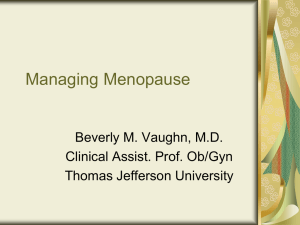
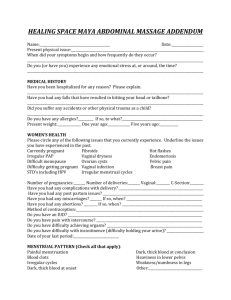
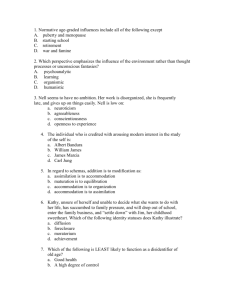
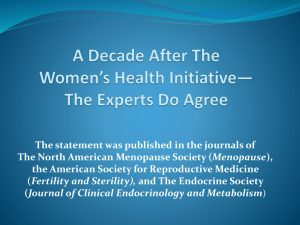
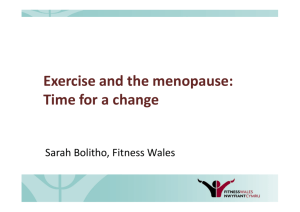
![Women's Health at All Ages Menopause.ppt[...]](http://s3.studylib.net/store/data/009081937_1-c188687977d4aa413ffb8558c5e0c10f-300x300.png)